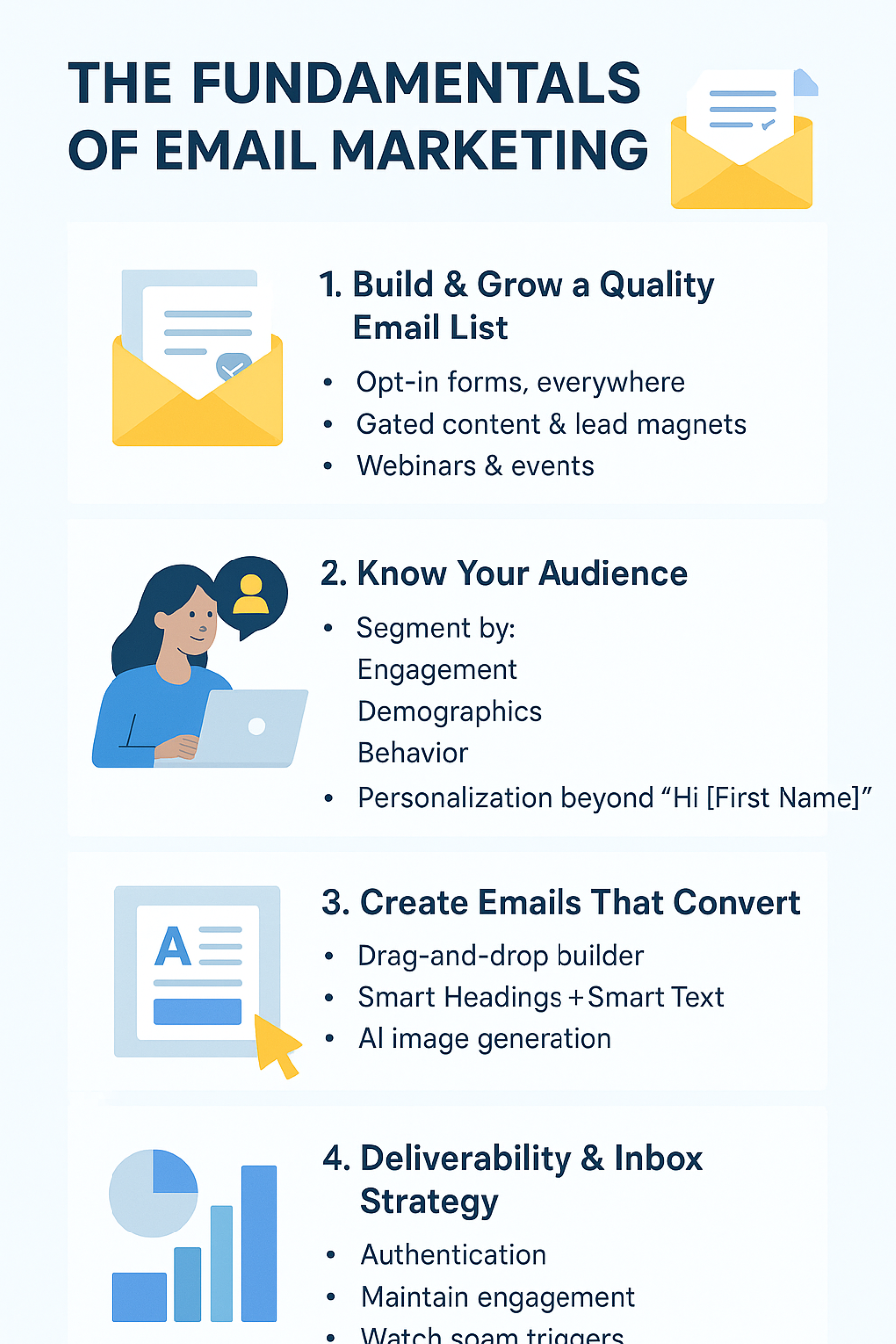
This blog post was last updated on 10/9/2025.
There are a multitude of great reasons to figure out an email marketing strategy that works for your business.
Email marketing campaigns are one of the most cost-effective marketing efforts you can make for your brand. Not only do email marketing campaigns help you reach a huge segment of your audience with one simple click. They’re also an essential tool for building brand awareness, converting prospects, staying top of mind with current and potential customers, and offering your audience an exceptional digital experience.
Need more convincing? Here are some impressive stats on what getting started with email marketing can do for your business:
- Email generates an average ROI of $42 for every $1 spent.
- Fifty-nine percent of B2B marketers cite email as their most effective channel for revenue generation.
- Eighty percent of business professionals find that email marketing increases customer retention rates.
It’s no wonder that marketers around the globe devote so much of their time and resources to email marketing, and why it’s become such a mainstay of effective outreach.
Plus, with rising privacy restrictions and algorithm uncertainties on social platforms, your email list is more of an asset than ever.
That said, the email game has evolved. Email tools are smarter (hello, AI), deliverability rules are stricter, and analytics are richer. With Benchmark Email, you’re not just getting a tool — you’re unlocking features built for this new era.
Before we dig into the how, here’s what works today:
- Permission-first lists (no sketchy buying)
- Clear, relevant content
- Strong deliverability hygiene
- Iterative performance measurement
- Compliance and data privacy awareness
Now—let’s map those fundamentals through the lens of Benchmark Email.
1. Build & Grow a Quality Email List (the Right Way)
Without a solid list, even the best email won’t land in front of interested eyes.
Best practices:
- Opt-in forms, everywhere: Place them on your homepage, blog posts, footers, social bios, and pop-ups. But nothing invasive — Benchmark supports embedding signup forms with smart design defaults.
- Gated content & lead magnets: Offer e-books, checklists, or guides in exchange for an email. But include an explicit opt-in for future emails (not just the gated asset).
- Webinars & events: Great for lead acquisition — but follow up with a sequenced email series (see below).
- Double opt-in/confirmation emails: Adds a layer of quality control and reduces the risk of bad addresses.
What to avoid:
- Never buy lists. They often bring spam complaints, poor engagement, and threaten your sender reputation.
- Avoid over-asking upon signup. Ask only for essentials (e.g., email, maybe name). You can collect preferences later.
Benchmark Tip: Use tags and segmentation early. For example, track which form a contact came from, or what’s their interest area — helps you send more relevant content down the line.

2. Know Your Audience (Segment and Personalize)
Today’s inbox is crowded. The way to stand out isn’t volume — it’s relevance.
Segment by:
- Engagement (opens, clicks)
- Demographics (location, role)
- Behavior (past purchases, content downloads)
- Preferences (topics they like, frequency)
Personalization beyond “Hi [First Name]”:
With our Smart Text tools, you can dynamically refine language to your audience. For example:
- Use conditional copy snippets (if a contact is from X region, show regional content).
- Use tone adjustment (formal vs casual) depending on the segment.
Always aim for “that feels meant for them” over “mass email.”
3. Create Emails That Convert (Using Benchmark Email Tools)
The core structure is timeless: subject line, preheader, header image or logo, body content, CTA, footer. But how you build and polish it is where our software shines.
Drag-and-drop builder:
Skip the HTML mess. Benchmark Email gives you modular blocks (text, image, button, divider, social), so you can assemble your email like a LEGO building.
Smart Headings + Smart Text:
- Subject lines & section headers: Use Smart Headings to auto-generate dozens of options. Choose ones that spark curiosity or urgency while staying brand-aligned.
- Refine your copy: Paste your draft into Smart Text. Want it shorter? More persuasive? More friendly? One click transforms it.
AI image generation (if included):
Need a visual and don’t have one? Our built-in image tool (if available in your plan) can help you generate custom visuals on the fly, aligned with your messaging.
Mobile-first mindset:
Always preview on mobile. Many templates adapt automatically, but complex blocks (side-by-side images, multi-column layouts) should be tested to ensure readability.
Call-to-Action (CTA) best practices:
- One clear primary CTA (e.g., “Shop Now,” “Download”)
- Place above the fold and at the bottom
- Use color contrast — make it pop
- Anchor text copying matters — prefer “Claim Your Spot” over vague “Click Here”
4. Deliverability & Inbox Strategy
Your email can be great — but if it doesn’t hit the inbox, it’s wasted effort. These are updated best practices for 2025:
Authentication is non-negotiable:
- Set up SPF, DKIM, and DMARC for your sending domain.
- Use a consistent “From” address (name + domain) instead of free platforms (e.g., Gmail).

Email Deliverability 101: Understanding the Basics of Making it to the Inbox
DOWNLOAD NOWMaintain engagement:
- Clean your list periodically. Suppress or re-engage unopens.
- Use re-engagement campaigns (e.g., “We’ve missed you. Want to stay in touch?”)
- Avoid sudden spikes in send volume — increase gradually as your list grows.
Watch spam triggers:
- Excessive capitalization or punctuation (!!!)
- Misleading subject lines
- Too many external links in early sections
- Heavy HTML with little text (“image-only” emails)
Manage bounces and complaints:
- Automatically suppress hard bounces
- Monitor spam complaint rates — if they creep up, pause and audit
- Include a clear and easy unsubscribe link
Inbox variation and deliverability insights:
- Test toward major inbox providers (Gmail, Outlook, Apple Mail)
- Leverage Benchmark’s deliverability dashboards to spot anomalies (e.g., certain domains rejecting, user complaints)
- Use seed lists (internal test addresses across domains) to monitor actual placement
5. Measure Success with Updated Analytics
Metrics guide your decisions — but which ones matter now?
- Open rate: Still significant, but increasingly impacted by privacy settings (e.g., image blocking, Apple Mail’s proxy opens). Use this metric cautiously.
- Click rate / Click-to-open rate (CTOR): Much stronger signal of interest.
- Conversion / Goal rate: This is your money metric (purchase, signup, download).
- Unsubscribe and spam complaint rates: Signals of list health and content relevance.
- Engagement over time: Track trends per campaign, per segment.
- Deliverability & inbox placement metrics: Watch how many reach the inbox vs spam or promotions tab.
Benchmark Email advantage:
- You can tie email performance to behavior (e.g., if a contact clicked, then went to the site).
- Advanced segmentation allows comparing variants (A/B subject lines, layout changes).
- Export trends and share dashboards with stakeholders.
Pro tip: Don’t just look backward. Use data to predict what your following email should do: which subject lines get attention, which offers convert, which segments need more nurturing.
6. Compliance, Privacy & Regulation (2025 Edition)
You can’t ignore this — but you also don’t have to be terrified.
Key rules and trends:
- GDPR/CCPA/other regional laws: Always capture consent clearly. Make it easy to unsubscribe or manage preferences.
- Privacy updates & email tracking: With Apple Mail’s Mail Privacy Protection and similar features, open rate signals are blurred. That’s why click and conversion metrics are even more critical now.
- Data minimalism: Collect only what you need. If you ask for extra fields, explain why (e.g., “Your industry helps us tailor your content”).
- Retention & deletion policies: Define how long you keep inactive contacts and when to remove or re-consent them.
- Transparent footers & identity: Include your company address, contact info, and an unsubscribe option.
- Third-party integrations & data sharing: If sending email via integrations, ensure those systems are compliant (e.g., your CRM, e-commerce).
7. Plan, Iterate & Scale
Start simple. Then build.
- Campaign calendar: Decide your send frequency (weekly, biweekly, etc.) and themes ahead of time.
- Use A/B testing: Test subject lines, CTAs, layouts, or timings. Let Benchmark Email’s analytics tell you what wins.
- Iterate based on data: Don’t reinvent each time — reuse what works, discard what doesn’t.
- Prepare for growth: As you scale, you’ll want automation, more advanced integrations, and collaboration. Benchmark Email is built to grow with you.
Final Thoughts — From Fundamentals to Forward Motion
The basics of email marketing—good list building, relevant content, deliverability hygiene, measurement, and compliance—still matter. What’s changed is how we do them.
With Benchmark Email, you get modern tools (drag-and-drop editing, AI-powered Smart Text and Smart Headings, deep analytics, built-in deliverability infrastructure) that make executing those fundamentals faster, smarter, and more scalable.

Benchmark Recommends
See all articles
How to Prep Your List for Seasonal Sending Spikes
How to Make your Marketing Emails More Clickable with Interactive Content
How to Use AI to Write Smarter Emails (Without Losing Your Voice)
A powerfully simple email marketing platform
Sign up for free to see how effortless email marketing can be.
Our Company
Compare
Solutions
Compare
Account
© Polaris Software, LLC 粤ICP备14001834号 Benchmark Email® is a registered trademark of Polaris Software, LLC
© Polaris Software, LLC 粤ICP备14001834号
Benchmark Email® is a registered trademark of Polaris Software, LLC



